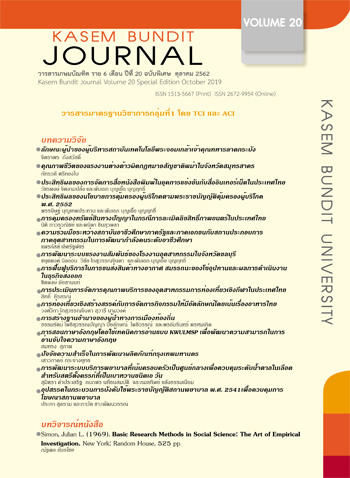Creative Tourism and the Management of Activity Uniqueness with an Emphasis on Thai Food
Keywords:
Activity Uniqueness, Ccreative Tourismtourism, Thai cooking class, Thai foodAbstract
This study aimed to create Thai food activity uniqueness for creative tourism. The quantitative approach was employed for a sample survey of 400 foreign tourists at Thai cooking class in Chiang Mai, Thailand. The Exploratory Factor Analysis (EFA) was used to analyze data. The results revealed 6 main components, i.e. value and experience, content activity transfer to tourists, authenticity of activity, differences from general tourism activity, worthiness of participation, and different from normal social and daily life were important factors to create Thai food activity uniqueness for creative tourism. The most significant factor influencing Thai food activity uniqueness was the creation of great value and experience for tourists who participated in the activities.
References
Ashton, S. (2014). Tourist destination brand image development an analysis based on stakeholders' perception: A case study from Southland, New Zealand. Journal of Vacation Marketing, 20(3), 279–292.
Belk, R. W. (1988). Possessions and the Extended Self. Journal of Consumer Research, 15, 139–168.
Bian, Q. & Forsythe, S. (2012). Purchase intention for luxury brands: A cross cultural comparison. Journal of Business Research, 65, 1443-1451.
Burns, D. J. & Warren, H. B. (1995). Need for uniqueness: shopping mall preference and choice activity. International Journal of Retail & Distribution Management, 23(12), 4-12.
Chang, K. C. (2014). Examing the effect of tour guide performance, tourist trust, tourist satisfaction, and flow experience on tourists’ shopping behavior. Asia Pacific Journal of Tourism Research, 19(2), 219-247.
Chang, L. L., Backman, K.F. & Huang, Y. C. (2014). Creative tourism: a preliminary examination of creative tourists’ motivation, experience, perceived value and revisit intention", International Journal of Culture, Tourism and Hospitality Research, 8(4), 401-419,
Chen, C. F. & Tsai, D. C. (2007). How destination image and evaluative factors affect behavioral intentions?. Tourism Management, 28, 1115-1122.
Clark, R. A. & Goldsmith, R. E. (2005). Market mavens: Psychological influences. Psychology & Marketing, 22(4), 289-312.
Costello, A. B. & Osborne, J. W. (2005). Best Practices in Exploratory Factor Analysis: Four Recommendations for Getting the Most From Your Analysis. Practical Assessment, Research & Evaluation. 10(7), 1-9.
Fisher, R. J. & Price, L. L. (1992). An Investigation into the Social Context of Early Adoption Behavior. Journal of Consumer Research, 19(December), 477–486.
Gross, H. E. (1977). Micro and macro level implications for a sociology of virtue: The case of draft protesters to the Vietnam War. Sociological Quarterly, 18(Summer), 319–339.
Heckert, D. M. (1989). The Relativity of Positive Deviance: The Case of the French Impressionists. Deviant Behavior, 10(Spring), 131–144.
Jira Buathong. (2014). Destination Thailand Thailand's index as a destination for tourists. TAT Tourism Journal. Quarter 4/2014 October – December. (In Thai)
Keng, C. J., Tran, V. D., Liao, T. H., Yao, C. J. & Hsu, M. K. (2014). Sequential combination of consumer experiences and their impact on product knowledge and brand attitude: The moderating role of desire for unique consumer products. Internet Research, 24(3), 270-291.
Kron, J. (1983). Home-Psych: The Social Psychology of Home and Decoration, New York: Potter.
Kovathanakul, Donruetai. (2015). Discover Thainess. MICE & Tourism iSaanbiz Week News, March 2015. (In Thai)
Lehto, X. Y., O’Leary, J. T. & Morrison, A. M. (2004). The effect of prior experience on vacation behavior. Annals of Tourism Research, 31(4), 801-818.
Lew, A. & McKercher, B. (2006). Modeling Tourist Movements: A Local Destination Analysis. Annals of Tourism Research, 33(2), 403–423.
Lynn, M. & Harris, J. (1997). The desire for unique consumer products: A new individual differences scale. Psychology & Marketing, 14(6), 601-616.
McAlister, L. & Pessemier, E. (1982). Variety seeking behavior: an interdisciplinary review. Journal of Consumer Research, 9, 311–322.
Ministry of Tourism and Sports. (2014). The department of tourism and sports development strategic plan 1-5 National Tourism Year 2012-2016. Retrieved from https://www.mots.go.th/ewt_dl_link.php?nid=7100 (In Thai)
----------. (2015). Department of Tourism: A summary of the tourist situation.
----------. (2016). Department of Tourism: A summary of the tourist situation in August 2015.
Morgan, N.J., Pritchard, A. & Piggott, R. (2003). Destination branding and the role of the stakeholders: The case of New Zealand. Journal of Vacation Marketing, 9(3): 285-299.
Qu, H., Kim, L. H. & Im, H. H. (2011). A model of destination branding: Integrating the concepts of the branding and destination image. Tourism Management, 32: 465-476.
Sin Sarobol. (2004). Community-based tourism management. Research Community, 57(10/11): 15-21. (In Thai)
Snyder, C. R., & Fromkin, H. L. (1980). Uniqueness: The human pursuit of difference. New York: Plenum Press.
Tian, K. T. & Bearden, W. O. (2002). Distinguishing consumers’ need for uniqueness from individuation and general need for uniqueness. Emerald Group Publishing Limited, 11: 171-198.
Tourism Authority of Thailand. (2012). Thailand Destination Image Final Report. Eureka Consulting Company Limited. (In Thai)
Tourism Authority of Thailand. (2015). Tourism Promotion for Thailand; Tourism on the move. TAT Tourism Journal, 1(4), Quarter 4/2015 October – December.
UNESCO. (2008). Creative tourism conference defines a new travel experience. Retrieved from https://www.eturbonews.com/4539/creativetourism-conference-defines-new-travel-experience
Volkova, N. & Muller, J. (2012). Assessing the Nonaviation Performance of Selected US Airports. Transportation Journal, 51(3): 289-304
Watkins, K.E., Ferris, B. & Rutherford, G. S. (2010). Explore: An Attraction Search Tool for Transit Trip Planning. Journal of Public Transportation, 13(4), 111-128.
Williams, B., Osman, A. & Brown, T. (2010). Exploratory factor analysis: A five-step guide for novice. Journal of Emergency Primary health care (JEPHC). 8(3): 1-13.
Ziller, R. C. (1964). Individuation and Socialization: A Theory of Assimilation in Large Organizations. Human Relations, 17(4): 341–360.
Downloads
Published
How to Cite
Issue
Section
License
ทัศนคติ ความคิดเห็นใด ๆ ที่ปรากฏในวารสารเกษมบัณฑิตฉบับนี้เป็นของผู้เขียน โดยเฉพาะ มหาวิทยาลัยเกษมบัณฑิตและบรรณาธิการ ไม่จำเป็นต้องมีความเห็นพ้องด้วย







